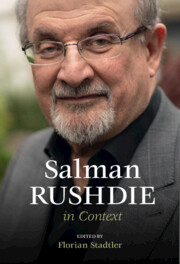Book contents
- Salman Rushdie in Context
- Salman Rushdie in Context
- Copyright page
- Dedication
- Contents
- Contributors
- Acknowledgements
- Introduction
- Part I Life
- Part II Literary and Creative Contexts
- Part III Historical and Cultural Contexts
- Part IV Critical Theoretical Contexts
- Part V Reception, Criticism, and Adaptation
- Chapter 26 Salman Rushdie’s Audiences, Reception, and the Literary Market
- Chapter 27 Adapting Rushdie
- Works by Salman Rushdie
- Select Bibliography
- Index
Chapter 27 - Adapting Rushdie
Radio, Screen, and Stage
from Part V - Reception, Criticism, and Adaptation
Published online by Cambridge University Press: 23 March 2023
- Salman Rushdie in Context
- Salman Rushdie in Context
- Copyright page
- Dedication
- Contents
- Contributors
- Acknowledgements
- Introduction
- Part I Life
- Part II Literary and Creative Contexts
- Part III Historical and Cultural Contexts
- Part IV Critical Theoretical Contexts
- Part V Reception, Criticism, and Adaptation
- Chapter 26 Salman Rushdie’s Audiences, Reception, and the Literary Market
- Chapter 27 Adapting Rushdie
- Works by Salman Rushdie
- Select Bibliography
- Index
Summary
This chapter focuses on the ways in which Salman Rushdie’s works have been adapted for stage, screen, and radio. Focusing on adaptations of Midnight’s Children for the RSC, Haroun and the Sea of Stories for the National Theatre, radio versions such as Midnight’s Children for BBC Radio Four, a proposed Netflix serialization of the novel, as well as its film adaptation, this chapter considers the pitfalls and strengths in the processes of adaptation, on which Rushdie has written himself on the occasion of his writing the screenplay for the novel for Deepa Mehta’s film adaptation. The chapter considers also the audiobook versions of major novels, such Art Malik’s reading of The Moor’s Last Sigh or Rushdie’s own reading of Haroun and the Sea of Stories and East, West, and some of the failed adaptions, such as Raul Ruiz’s attempt to produce a film of The Ground Beneath Her Feet. In so doing, the chapter considers the transposition of Rushdie’s work into other media and highlights how their unique originary artistic forms make them a difficult adaptive proposition.
- Type
- Chapter
- Information
- Salman Rushdie in Context , pp. 344 - 355Publisher: Cambridge University PressPrint publication year: 2023

